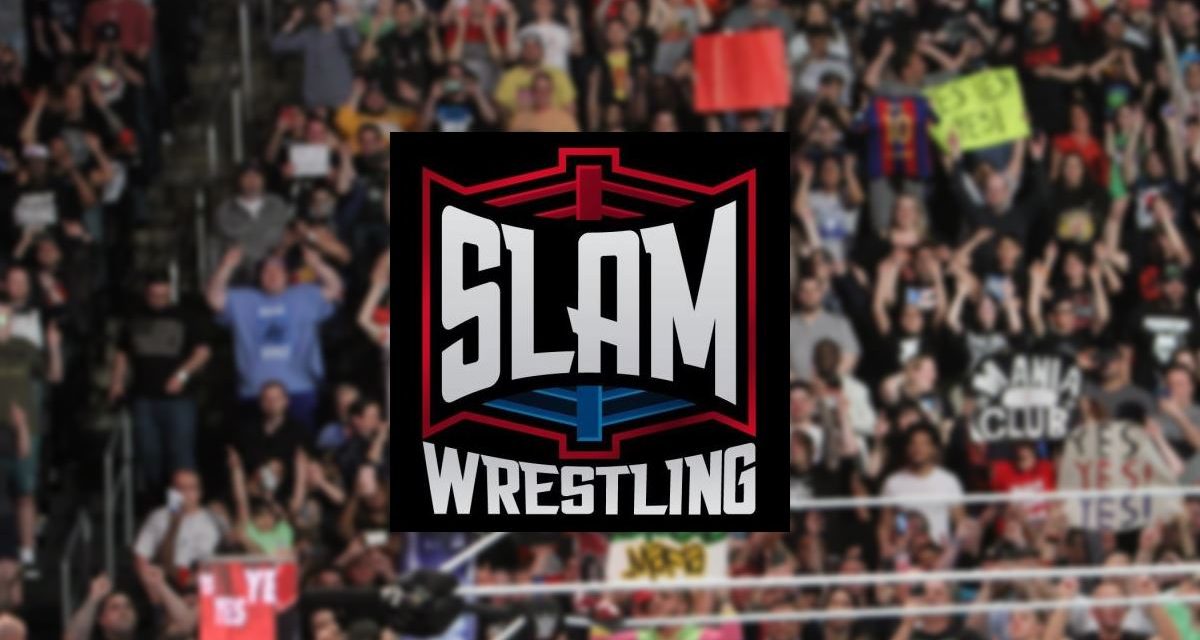Sitting in Steve Yohe’s living room and talking about wrestling history is an experience that, if you’re lucky enough to have it, you won’t soon forget. The room is packed, packed, packed with loose stacks of paper, DVDs, action figures, and books. Open any cabinet and you’ll find it stacked with paper. Try to move around without making a mess and you’ll have to rearrange a stack of paper, first.
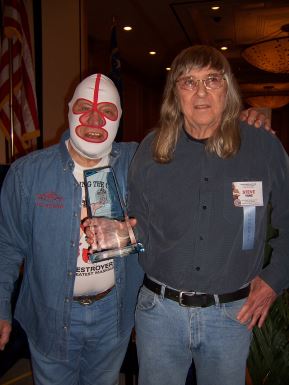
The Destroyer Dick Beyer and Steve Yohe in 2009 at the Cauliflower Alley Club reunion, after Yohe received its historian’s award. Photo by Mike Lano, WReaLano@aol.com
Yohe himself cuts a unique figure; taller than you’d expect with stooped shoulders and shoulder-length grey hair. In person, he’s funny and smart and compassionate. And when he talks wrestling history, people like Joe Stecher and Ed Lewis feel alive, contemporary. “It’s not old to me,” he says. He is one of the most passionately lit-up guys you’re going to meet and in a more just world, a forward-looking university would have long ago granted him an honorary PhD and installed him in their American Studies department, where he could have devoted himself full-time to studying, writing about, and lecturing on the history of professional wrestling.
Yohe was born in Compton, California in 1948. In 1952, his family moved to Montebello, a small town just outside of Los Angeles that he jokingly calls “the Beverly Hills of East LA.” He still lives in his family home, a single-level house sitting on a sunny street set back off of the main stretch, with his wife. On a good day, it’s a 20-minute drive from the site of the former Olympic Auditorium, home to the Los Angeles wrestling promotion that he grew up on. He and his brother first started watching it on TV for the unforgettable interview segments, but Yohe soon fell in love with the matches. “The first great match I ever saw was Lou Thesz against the Zebra Kid,” he says. “I loved it. I was hooked on it.”
It was the arrival of Dick Beyer as The Destroyer in the Los Angeles territory that made him a fan for life. (A framed picture of The Destroyer in action still hangs in Yohe’s living room.) “I try not to be a fanboy, but I’m a Destroyer fanboy,” he says. “He could do it all.” Convinced that a particular match between The Destroyer and Shohei Baba would result in Beyer finally having to take off his signature white and red mask, Yohe made his parents take him down the street to the Olympic to see it happen live. “I still say it’s the greatest match I’ve ever seen. When The Destroyer tricked Baba and pinned him, the fucking air went out of the building. There was yelling and screaming and they were going crazy and when he pinned him, the air just sucked out of the building. No noise. I remember sitting in the parking lot and the people walking by and they were laughing about how The Destroyer tricked this big 7-foot guy, and I was thinking, ‘This is the greatest.’ You’ve got two guys in the ring, and all they’re wearing is trunks and one guy’s got a mask, and you’ve got a referee and you’ve got a bell and you’ve got a ring. And it draws 10,000 people and it’s just the most thrilling, greatest thing.”
After graduating from high school, he joined the army and was deployed to Vietnam in 1967. “The first time I was in the army I was a hippie and I was against the war. I was there but I was against it and I told them about it. I hated it.” He describes himself, ultimately, as lucky. “Nothing really happened to me. They used to mortar us constantly but I had nothing really major. Three weeks after I left, there was a land attack and four guys in my platoon were killed. There were 20 guys in my platoon and 12 of them got messed up.”
After finishing his service, he attended East Los Angeles College and Cal State Los Angeles. There, he pursued his passion for basketball. He’d played constantly as a child but never received formal coaching. Having grown to over 6 feet tall by the time he was only 12, as soon as he and his friends could drive they travelled around East Los Angeles looking for pick-up games. He continued playing during his first tour of duty with the Army and his four years of college provided him even more opportunity to dig-in. “I took theory of basketball twice with the coaches at Cal State LA,” he says. “I eventually got pretty good but no believes it anymore.”
After graduating, he re-enlisted in the army and trained as a medic. He worked at the Institute of Surgical Research, the military’s world-class burn hospital in San Antonio, before taking a job as an overnight nurse at Alhambra Hospital, outside of Pasadena, where he worked until his retirement in 2015. In both positions, he cared for the gravely injured and infirm. It reflects a caring nature that he balances with an occasionally curmudgeonly exterior. While working in health care, for example, he preferred the night shift, he says, because “I wanted to have my hair long and I didn’t want anyone fucking with me and I didn’t want to
hang around with doctors. Even today, I don’t get up until 12 p.m. and I don’t go to bed until 5 in the morning.”
Yohe had graduated high school with almost no ability to write, but slowly learned in the army and as part of his college writing courses. “I was a good reader, but I could not write at all and even to this day I cannot spell.” An avid reader of Dave Meltzer’s Wrestling Observer Newsletter, he marks either 1992 or 1993 as the year he seriously began his research into wrestling history. He began sending in letters that Meltzer would publish in the Observer, giving Yohe his first real encouragement to try improving his skills. “I write like I talk. I started every sentence with ‘Hey.’ It was terrible.” He now calls Meltzer “god-like,” crediting him with bringing a new level of intelligence and credibility to wrestling journalism.
Around the same time, a fellow wrestling fan and friend, John Williams, took Yohe to the library and introduced him to the microfilm machines. From there, he’s been at his research non-stop. “Meltzer said that pro wrestling was a sport without a history. I decided I was going to try and give it a history. And that’s what I’ve been doing. I take in everything everybody says and I try to make something out of it and figure it out.”
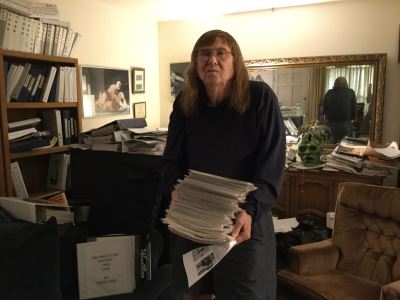
Steve Yohe in his element. Photo by Jon Langmead
He’s produced record books and detailed essays on a list of wrestling figures, including Maurice Tillet, Earl Caddock, Sandor Szabo, Frank Seton, Ali Baba, and promoter Jack Curley. His outstanding book on “Strangler” Ed Lewis, Facts Within a Myth, is essential reading for anyone with even a passing curiosity in wrestling history.
Yohe is part of the modern group of historians who built the history that everyone since has relied on. Without people like him, Don Luce, Mark Hewitt, Jim Melby, Koji Miyamoto, Haruo Yamaguchi, and Fred Hornby, much of wrestling history would still be unclear. “We worked as a group. They sent me their stuff, I sent them mine. Everything I did, it was always a group. Nobody knew shit 20 years ago. There were a bunch of history guys but they weren’t in the sheet world. And I evolved from the sheet world and went into the history.”
The late J Michael Kenyon, who was known around SLAM! Wrestling as the master of mat history, called Yohe an “outspoken, highly opinionated, demon researcher, esteemed colleague,compiler of Gargantuan career record books, and a man who should forever be remembered for his massive contributions to defining professional wrestling history.”
Yohe has likely given the history of wrestling in the 20th century as close a read as it has ever received, tracking not only who was wrestling whom and when, but who were they working for, who was making the pay-outs, and what else was happening in wrestling that was having a bearing on events. These details matter, he’ll tell you, because if you want to know the truth in wrestling, you can’t trust the performers and the promoters to tell it to you. You can only know it by following the results and the championships and the gates. The story of wrestling is in who is drawing fans, who is winning and losing, and where and when and to who and how often. In a sport where the outcomes of the major matches are determined weeks or months before the match even begins, the person who gets declared the winner is always picked for a reason. Yohe’s passion as a historian has been focused on finding out the reasons.
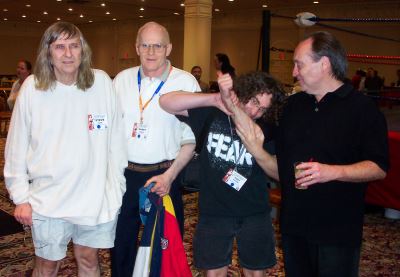
Steve Yohe, the late Harry White, a hungry Kurt Brown and Mike Tenay at a Cauliflower Alley Club reunion in Las Vegas. Photo by Mike Lano, WReaLano@aol.com
His approach has been to take the look-behind-the-curtain attitude of the Wrestling Observer and apply it to history. Why, for example, would Jim Londos go years without losing as much as a fall, but choose to lose cleanly to Danno O’Mahoney in 1935? And not just lose cleanly but call O’Mahoney the “better man” afterwards? Was it tied to the fact that Londos had drawn only 4,000 people to a match at Madison Square Garden earlier that year, when only a few years before he’d been drawing almost 20,000? Or was it that Londos wanted a break after years of travelling the country and O’Mahoney was a successor that everyone could agree on? “John Williams was a big influence,” Yohe says. “We both had the opinion that things never really change. People don’t change. Human nature doesn’t change and 100 years isn’t a long history. They think like we think.”
Anyone who has taken even a glance at the major wrestling events from the 1920s or ’30s will understand Yohe’s obsession. The story is alluringly opaque. A victim of a supposed double-cross is found to be working with his rival a year later. Something that looked like it had gone according to some bigger plan turns out to have been a surprise to everyone involved.
The reason for all of the confusion, he thinks, is that the promoters who ran wrestling wanted to keep fans guessing. The less anyone was able to piece together into a larger narrative, they thought, the better. All of the obfuscation, though, has made the process of putting the story together, after the fact, all the more challenging.
Gary Will and Royal Duncan’s book, Wrestling Title Histories, turned out to be a particular help early in Yohe’s process. Using that as a map, he searched for the newspaper clippings leading up to, and immediately following, major title changes. He collected the clippings into books that he filed on the shelves tha
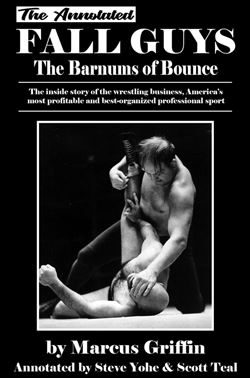
Dick Shikat gives Ali Baba the what’s what. Cover of reissue of Fall Guys by Marcus Griffin, now available in a new annotated version by Steve Yohe & Scott Teal. Check it out at crowbarpress.com
t now line his living room. The collection has grown over two decades, and the binders now fill the room. “I did it all for myself but then after I did it, I felt like I had to do something with all this stuff,” he says. “I wouldn’t have gotten a computer if it wasn’t for having to get this information out.” He began photocopying and binding the subject files into what he called Yohe Presses. From there, he mailed them to fellow historians, free of charge. In return, many sent him their own clippings. He kept it all, and his library grew and grew.
Collected in Yohe’s binders is a near complete record of pro wrestling from before the turn of the century into the 1950s. His shelves are filled with dozens and dozens of black and white three-ring binders. Down the spines run the names of the long-dead greats of pro wrestling; George Hackenschmidt, Bill Longson, Dick Shikat, Freddie Blassie, Bronko Nagurski, Buddy Rogers. Each is Yohe’s attempt to chronicle a specific wrestler’s career through newspaper articles and personal artifacts.
His shortest collections run around 200 pages. His most in-depth, like the ones on Ed Lewis and Jim Londos, can run over a thousand pages spread across multiple binders that are bursting apart at the seams. Each is arranged chronologically, and each tells a particular story. Some are phenomenal works of biography. The binder for Joe Stecher, for example, contains dozens of Stecher family photos that Yohe tracked down.
And when you start asking him questions about each one, he can fire off detailed answers, as if he’d just finished reading about whichever subject you were curious about just before you’d arrived. His brain, agile and always turning, is packed full of dates and names and other countless details. He can take you through long asides on Orville Brown’s reign as MWA champion. A casual question about whether or not wrestling promoter Jack Curley was really knocked unconscious in the melee that followed the 1932 match between Ed Lewis and Ray Steele in Madison Square Garden draws a response that, yes, not only was Curley assaulted but also that the assault was only reported in the Philadelphia papers. Curley, Yohe guesses, was influential enough with New York sportswriters to keep the incident out of their columns. Either that, or they thought it was too shabby a detail to discuss.
And each beautifully winding answer invariably ends with him smiling and self-deprecatingly saying, “Why are you asking me about this? No one cares about this shit.”
He’s right, of course, but only to a degree. The number of people who care about this shit; about Caddock and Lewis and Gotch, to say nothing of Zbyszko and Carkeek and Pesek, is incredibly small. But they’re out there, and that a new generation of fans cares at all is largely thanks to the unheralded work of people like Yohe. And if you ever ask him how he knows all this stuff, the answer is almost always the same: it’s all in the newspapers, he’ll tell you, if you read them closely enough.
“When I was in school, I was the dumbest guy you could find,” he says. “I could never spell. I still can’t spell, and never had a memory for anything. But I remember all the wrestling results, from the beginning. I could tell you where they were and everything. And I knew all the wrestlers. That’s something I never I had trouble with… It’s what you like, what you have an affinity for. And that’s what I had for wrestling. I understand wrestling somehow and I always understood it, right from the beginning.”
He is currently focused on two projects that pull together the different strands he’s been following all these years. First is a fresh look at Marcus Griffin’s wrestling expose Fall Guys. Griffin’s book, published in 1937, has influenced every person who has ventured to write about wrestling in any kind of serious way, since. While Griffin had direct access to many of the people who helped shape wrestling in the 20th century, he didn’t always get the story right. To be released on Scott Teal’s Crowbar Press, Yohe and Teal’s book looks to correct Griffin’s mistakes, intentional and otherwise, and fill in the backstory for the areas he overlooked.
Second is what he’s calling the Almanac of Pro Wrestling. The work is intended to be a day-to-day history of wrestling starting from the late 1800s. It’s a “who”, “what”, “where” history of a sport that was intentionally left undocumented by its participants. And more amazingly, in some instances it’s also a “why,” the dates and details of a particular event filled in with Yohe’s take on what was driving things. It’s a colossal effort on his part. The latest version runs over 1,000 pages, though he half-jokes, he’s only into the 1940s. There are plans to compile it into book form, but it may prove to be impossible. Incredibly, he’s posting piece-by-piece previews of it on the Wrestling Classics message board, free of charge.
In 2009, the Cauliflower Alley Club honored Yohe with its James C. Melby Historian Award. He was the second person to ever receive it, and it was fitting recognition. Through his research, he’s proven himself eager to push through conventional wisdom, challenging even the wrestlers themselves over their records and recollections of events. It’s all been in the service of finding the real story behind this unique and enduring art-form. “As goofy and as fucked-up as I am, I put wrestling ahead of everything else. It’s performance art done by two guys in shorts. They create something using motion and pure emotion that’s really wonderful.”
YOHE & THE BEAR
Steve isn’t just a guru of wrestling history, he’s a one-time, literally one-time, wrestler. His chance to step into the ring came as a 15-year old against the world-famous Victor the Bear. Victor wrestled at the Olympic, appeared on the Mike Douglas, Johnny Carson, and Ed Sullivan shows, and starred alongside Clint Eastwood and Lee Marvin in 1969’s Paint Your Wagon. Yohe encountered Victor while he was performing at the used car garage where his brother worked. By his account, the match was a snoozer, closer to Joe Stecher and Ed Lewis in Omaha than Ricky Steamboat and Randy Savage in Michigan. It ended in a 20-minute draw. Steve got a t-shirt covered in bear fur and grime and Victor, as was his usual reward for a hard-fought match, got a bottle of soda.
RELATED LINKS
